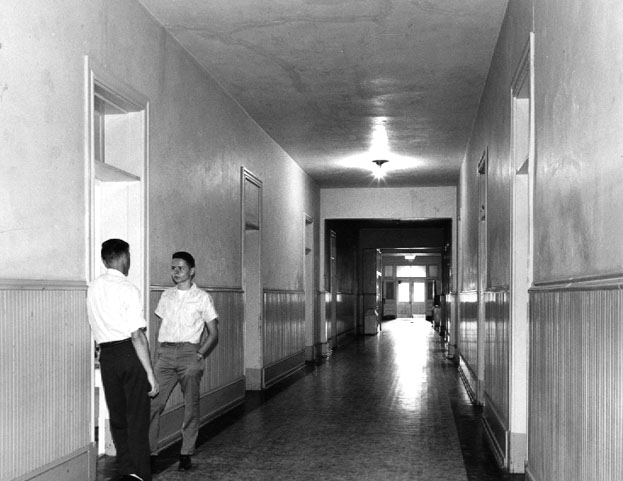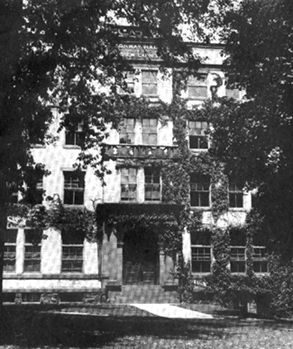
Two students talking in hallway near entrance of Conway Hall c. 1960's

Another event, however, a devastating fire which destroyed another building on campus, Denny Hall, placed the real financial burden on President Reed and his Board of Trustee membership. Rebuilding on an expanded foundation was authorized yet insurance only covered $17,000 of the total cost estimated at $60,000.2 Out of desperation, President Reed contacted Dickinson College alumnus Moncure Conway, class of 1849 and trustee from 1892-1894, seeking any available monetary offerings. In turn, Conway sought out the assistance of good friend and successful entrepreneur, Andrew Carnegie. Upon hearing of the fire, Carnegie readily donated $55,000 to the College under the condition that the new building would be dedicated to Conway. Carnegie's condition presented created a predicament for the administration. When Denny Hall was originally constructed, both the land on which it was to stand and construction money was given by the Denny family of Pittsburgh and an agreement was made that the building would stand as a memorial to the family, therefore, the name could not be changed. At this point, Reed informed Conway and Carnegie about the new preparatory school and how payments were late as the fire had set the school back financially. The $50,000 donation from Andrew Carnegie was then transferred to this project. As a symbol of gratitude, President Reed wished to inscribe "The Gift of Andrew Carnegie" under the Conway name but Carnegie refused. He informed Reed that he never allowed his name to be used unless he contributed the total amount. President Reed then responded astutely that the actual cost of the project was $63,480. Shortly thereafter, Carnegie produced a check to the college for the remaining $13,480 and the building was named after Moncure Conway with an inscription to Andrew Carnegie underneath.3 Carnegie's donation was the largest individual gift the college had ever received up to that time.

Exterior of Conway
Hall c.1905
Upon completion, Conway Hall stood as a seventy- eight feet wide,
183 feet deep and four story high structure with white exterior walls with
brownstone trim. It accommodated more than one hundred students and
necessary teachers. The building provided dormitory rooms for all
the school's enrolled females boarded at the nearby Ladies Hall.
The first floor was used for administration offices, recitation rooms,
halls for literary societies, study halls, and a large dining room.
A chapel which had room for 300 worshipers was located on the second floor.
Services were held every day at 8:15 am except on Sundays. The rooms
were heated by steam and lighted by electricity and windows in every room
provided sufficient ventilation. In the rear of the building stood
a two story annex containing a kitchen and a suite of rooms for the residential
matron. Conway Hall served as the complete home for an excellent
boarding school with a complete high school curriculum.4
Unfortunately, due to low enrollment, the Dickinson Preparatory
School was closed in 1917. The College took advantage of this extra
space and used it as a male freshmen dormitory thus changing the usage
of many of the rooms. The large basement below the building, which
was formerly a storage space, now provided dressing rooms for athletic
teams. In 1930, Conway Hall was completely renovated. Each
room was furnished with steel beds, tables, chairs, and dressers leaving
the student to supply only bedding. Heat no longer came from steam
and was provided by the College central heating plant. On each floor
lived a proctor who supervised daily as well as any occasional nightly
activities. There were also two janitors and a night watchman who
aided in keeping things in order. The infirmary was located on the
second floor with a house mother who acted as nurse. Single and double
occupancy rooms on all floors were available to students for varying prices.
Suites were also available but not on the first floor. The cost of
a single ranged from $85 to $145 per year. Doubles cost between $130
and $260 to be split between both students and suites, being the most expensive
were priced between $170 and $275. The differences in costs depended
on the size of the room, floor level and number of windows. Rooms
on the first floor were generally more expensive.5
In the midst of World War II, a large section of the Dickinson College
campus was taken over by the 32nd Training Detachment, a United States
Army Air Crew Unit. In 1943, a group of 140 men entered the college
each month for a five month training course. Conway Hall was used
as barracks while other buildings on campus were used for additional purposes.
The program and use of Conway Hall continued until January of 1944.6
Conway Hall was located between High and Louther Streets.
It was in use until the summer of 1966 when it was razed to make room for
the construction of a new building on that site, the Boyd Lee Spahr Library.
Emilie Grenier